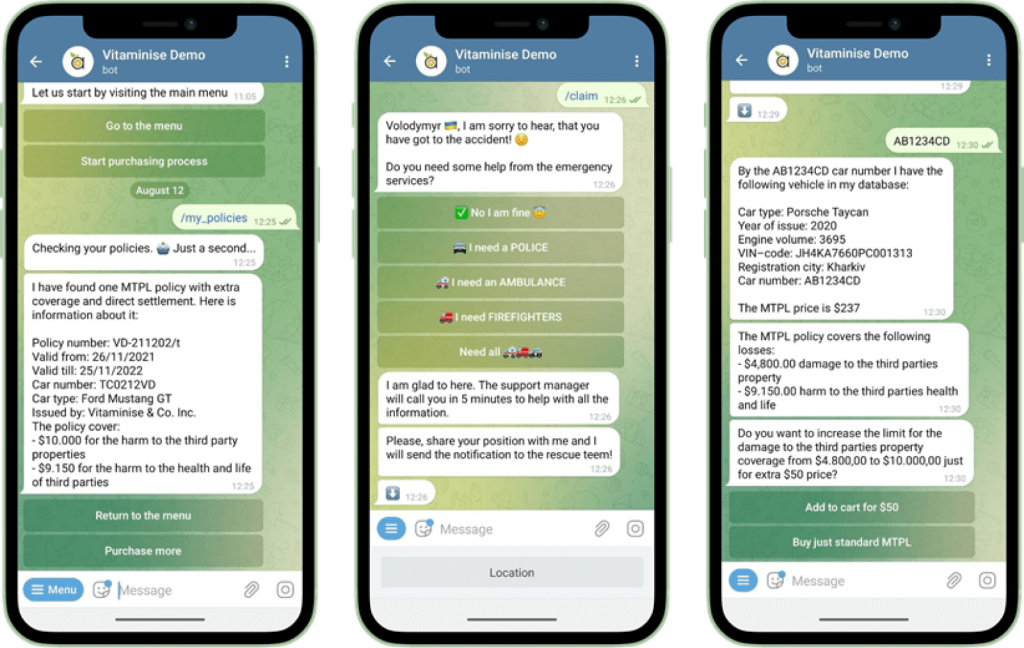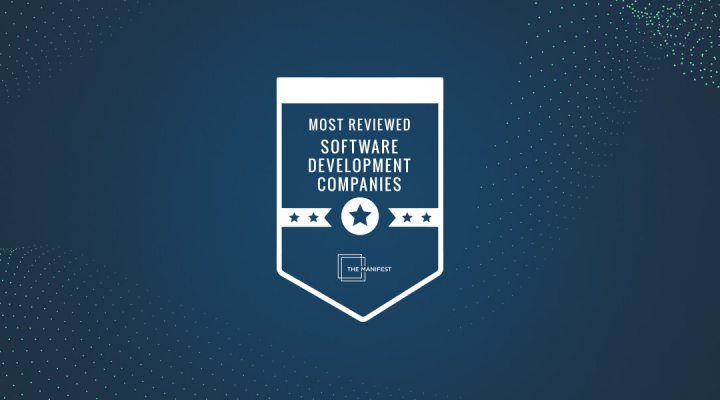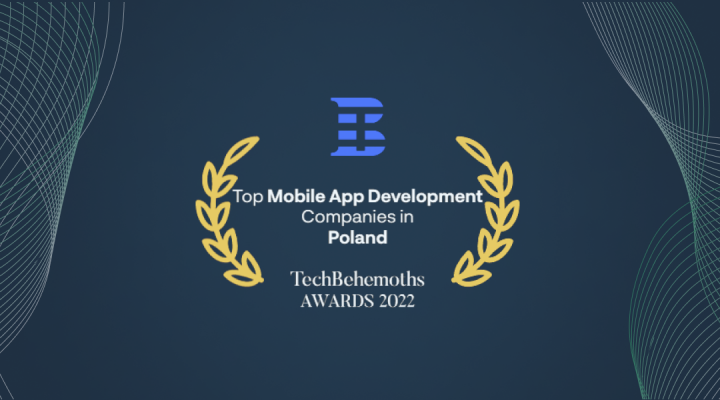
How to develop a chatbot for an insurance company?
Today’s insurers are closely studying trends and appreciating the innovative potential of chatbots. Powered by artificial intelligence (AI), they are capable of streamlining the widest range of operations, delivering an ultimate competitive advantage.
According to some estimates, this year, chatbots should save various industries about $8 billion in expenses. A significant part of this goes for the insurance business. No wonder because a chatbot is no longer just an interesting messaging interface but a “smart” tool for analyzing and offering products to the target audience. Although, according to experts, it is not yet mature enough.
At DICEUS, we are aware of such specifics firsthand, which is why we take an active part in making the technology more mature and available. In this article, you will learn about the use cases of chatbot deployment for insurance businesses, the benefits of chatbots, and how to develop a chatbot for your company.
Source: Cognizant
Use cases of deploying chatbots in insurance
Insurance companies receive a huge number of requests daily, which are nearly impossible to process timely and accurately, involving human resources only. A chatbot providing services 24/7 can come in handy for various purposes. Below are the most frequent use cases of chatbots for the insurance industry.
Customer onboarding
A chatbot significantly expands the possibilities of an insurance company to contact potential customers. It simplifies targeted marketing, while smart customer segmentation allows you to increase the number of attracted leads and corresponding conversion rates.
Instead of filling out piles of paper forms, chatbots offer convenient ways of providing customer information: submitting online forms, data auto-filling, sending replies to chatbots’ questions, etc.
Thanks to automated request processing, the client spends less time, and the business can standardize the process and store customer information conveniently. Chatbots can educate clients by showing “how it works” (policy purchase, making an appointment, filing a claim, etc.) and make suggestions based on customer behavior. AI bots also allow insurance customers to switch between different communication channels without having to “re-introduce themselves” (as it really annoys many buyer personas, according to DICEUS studies).
Claims processing
With the help of a chatbot, it is much easier to file claims at any time. It is enough for the insured party to disclose the nature of their claim in verbal form. After asking for a few details, the bot will extract the customer’s policy from the company’s CRM and immediately initiate the claim process. Simple and insignificant claims can be opened and recognized in the insurer’s system. After assessing the client’s damage, the insurance company reports the amount of compensation to the customer via a chatbot.
Payment assistance
A chatbot can help in choosing the optimal policy, as well as offer an overview of available insurance solutions that meet the client’s preferences. It can send payment reminders and thus facilitate the payment process through your preferred channel. A chatbot can “suggest” where to find the most convenient payment method.
Customer feedback
A chatbot allows you to exponentially empower your help desk by gathering customer feedback and addressing pain points with an open mind. With its help, customers can easily provide feedback about the services received and share them with other customers. Insurers, in their turn, receive helpful information on how their products and services can be improved.
Status notifications
A chatbot can send the client information about upcoming account updates, payment dates and amounts, and claim statuses with the click of a button. On top of that, they can also offer after-sales service at favorable terms for the customer.
Policy sales
Based on machine learning (ML), chatbots can predict which insurance policies a client is more likely to buy. The collected data helps chatbots increase cross-selling efficiency. Thanks to the segmentation function, personalized offers and discounts can be provided to customers.
Related article:
What is middle-layer architecture, and why does the insurance sector need it?
Benefits of using chatbots for insurance businesses
A chatbot provides an enhanced customer experience with self-service functionalities. It provides real-time problem-solving opportunities and more major benefits where that comes from.
24/7 support
Clients get accurate answers to difficult questions at any time. Using chatbots ensures that the information provided is up-to-date and consistent with the insurer’s policies and standards.
Efficient operations
A chatbot can accurately determine intent and provide personalized client recommendations. Thanks to that, the likelihood of conversion can be increased. Automation increases the productivity of customer service departments that can devote their time to other problems.
A chatbot reduces the number of calls and, in general, the need for customers to contact the corporate service center, which helps to optimize processes and leads to overall savings. Thus, resources associated with hiring and training employees can be saved.
Easy integration with messengers
End-to-end integration makes it easy to deploy chatbots on top of popular instant messengers and other real-time sales channels. You can use existing platforms or develop your own environment.
Integrations with core systems
A chatbot is connected to the insurer’s core system and can authenticate the client. The process of sending and checking documents becomes easier. The chatbot can retrieve the client’s policy from the insurer’s database or CRM, ask for additional details, and then initiate a claim.
Fast replies and feedback
Searching for products and filing claims are simplified as well. The client can do both at any time, if necessary, receiving an instant response to the question of interest from a chatbot.
User-friendly AI conversational experience
Machine and deep learning provide chatbots with a contextual understanding of human speech. They can even have intelligent conversations thanks to technologies such as natural language processing (NLP).
Source: Cognizant
Briefly on chatbot development
Implementation of the technology requires compliance with the following principles:
- Human-centric interface: Through NLP or ML capabilities.
- Contextualization of communication: The use of NLP and AI deepens the understanding of the nuances of human language by the chatbot and teaches it to respond accordingly.
- Scalability: The amount of traffic passing through a chatbot can grow substantially. The developer must provide for this.
- Multilingual support: The bot must understand multiple languages (if it is required by the business).
- Data protection: Clients share personal information with the chatbot, so relevant legislation must be considered.
Customer experience design
Before you create a chatbot, map out your client’s digital journey. Visualize the conversation. Define the value you want to offer, create a mental map of its effective implementation, and then build it into the design. Try to avoid over-gamification.
Conversation flow
Optimize the client-chatbot interaction. Determine what questions and why most clients are reluctant to answer. There are two things you can do here:
- Revise the phrase. Is the language used simple enough? Is the information requested too sensitive?
- Reduce the number of questions. Perhaps the list is too long, and the interaction is overly time-consuming.
Communication with the bot should have a natural course, without the need for much thought, but with clear control of all details. When developing dialogue scenarios, it is important that the topics of conversation are close to the purpose that the chatbot serves.
NLP
The implementation of natural language processing allows clients to freely exchange messages with a chatbot, which provides detailed feedback and adds personality to the interaction. Essentially, you are using an algorithm to understand your clients. You must be able to map out every possible outcome.
Leverage client behavioral data to optimize conversation design and workflow. Analytics will provide insights that your customer service team can glean from intuition. Chatbots can make them measurable and scalable. They cannot replace the customer service team, but they will take the load off that team and make their workflow more manageable.
Surely, you first need to determine the optimal architecture and operational principles and then choose the tools to implement them.
Source: Cognizant
Among code-based frameworks, the market-leading solutions include the Microsoft bot framework, Aspect CXP-NLU, API.ai, and Wit.ai.
After creating an MVP, you can start testing, then training your chatbot, as well as integrating it with external systems, all of which are quite complex tasks.
Chatbot development case study: DICEUS expertise
The car insurance chatbot we developed for our client, Vitaminise, provides transparent communication and helps consumers easily understand key insurance processes, including pricing. The solution implements the key functionality of selling insurance products with the data autofill function. Customers can submit an application, answer the questions of the insurance inspector, and receive payments directly through the chatbot.
Its implementation required some changes to the API code. Users have convenient access to insurance products through instant messengers, mobile applications, and a web portal, and the insurer can instantly interact with end customers.

Chatbot guarantees a range of advantages:
- Buying insurance in 2-3 minutes via one’s smartphone without the need for manual data entry
- Availability 24/7 worldwide
- Convenient collaboration with agents
- Claims management via smartphone
Integration with the payment gateway makes it possible to pay for insurance remotely. The user receives the digital policy by email. The big advantage is the data autocomplete feature. Clients can receive their policies in a PDF format from within the app or via email. The chatbot also solves the problem of managing client requests outside the office.
Conclusion
Chatbot development is an effective tool for improving customer experience and automating some operations in insurance businesses. Thanks to the expertise of DICEUS, many companies are successfully developing their business in this vector. We offer software products with a high level of interaction with the target audience and full-on post-deployment support. Contact us to boost your business with chatbot development.





